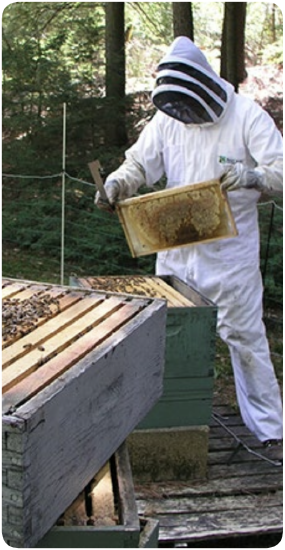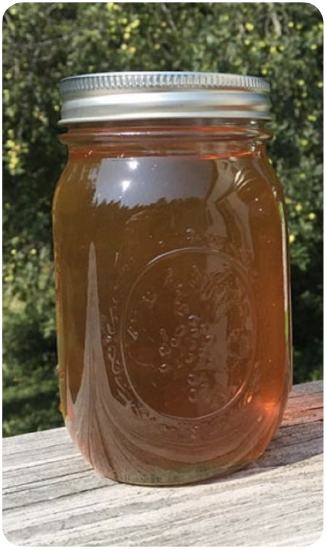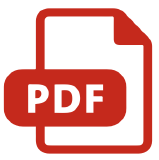5.4: Writing
- Page ID
- 91197
Writing is a big part of evaluation or assessment in education. Writing is often used to test learners’ knowledge and skills. Learners can also use writing to evaluate, assess, or review other things. Reviewers write about the quality of performances or products. Written reviews are a more formal genre of the rating we do in everyday conversations.
Scaffolding Genre-exploring Activity
The Maskwa Folk Music Festival has invited vendors of local products to promote and sell their goods. One product that appeals to many people is honey. The fields around Bear Bottom Campground are home to many bees. Healthy clover fields matter to beekeepers like Ivan. He and Oksana sell honey at their family farm, Broz Meadows.
Here is a review of their clover honey.
This local honey is very tasty. When you spread the delicious honey on hot, buttery toast, there is a really light floral aroma of clover. This creamed  honey is neither too firm nor too runny. You can also dip fresh fruit into the liquid honey, which has such a golden colour. The honey is so pure but not too clear. Just enough nutritious bee pollen remains in the table-top sizes that Oksana bottles for people with a delicate palate. This natural Canadian honey is such a healthy sweetener to add to your baking or drinks. Ivan keeps beehives on the organic clover fields where his family started beekeeping three generations ago.
honey is neither too firm nor too runny. You can also dip fresh fruit into the liquid honey, which has such a golden colour. The honey is so pure but not too clear. Just enough nutritious bee pollen remains in the table-top sizes that Oksana bottles for people with a delicate palate. This natural Canadian honey is such a healthy sweetener to add to your baking or drinks. Ivan keeps beehives on the organic clover fields where his family started beekeeping three generations ago.
Here is how Ivan reviewed another vendor’s honey products:
A sensible approach to rating honey is to use your senses. 
Sight: This liquid honey is a bee-autiful colour, but it’s too clear. It’s almost transparent, like it’s been heated.
Taste: Good honey is naturally sweet with layers of flavour. This product tastes too grassy. There are no notes of beeswax or vanilla.
Feel: A creamed honey should spread smoothly. This one is really hard. The texture is very sugary. The liquid honey is too runny. I’d call it watery. It flowed so fast that it spilled out of the bottle.
Smell: My senstive Broz nose can tell that the scent of clover is missing.
Don’t waste your money on this honey!
These two reviews compare similar honey products. They describe the same characteristics of honey: colour, aroma, texture, and taste. The descriptions show contrasts, or differences, in the products. 
Both reviewers mention facts and opinions. One is too complimentary. The review is so overly positive that it sounds like an advertisement. The second review is very critical. Ivan sounds almost entirely negative.
Scan both reviews for words that are positive or negative about the characteristics of the honey.
Fill in the blanks with combinations of descriptive words: adjectives and adverbs.
The first one is an example.
Positive Compliments
- very tasty
- aroma
- neither
- nor
- a colour
- honey is
- but
- bee pollen
- a sweetener
- colour
- with layers of flavour
Negative Criticisms
- It’s .
- This product tastes .
- This one is .
- The texture is .
- The liquid honey is .
- It flowed .
Scaffolding Mechanics, Grammar, and Syntax Activity
Describing with Adjectives and Adverbs
All of the reviews in this chapter rate people, performances, or products. The reviewers present facts that everyone can agree on. Adjectives add descriptive details that give a deeper understanding of how the reviewer feels about the topic.
The reviewer who reviewed Ivan’s and Oksana’s products didn’t simply write about the honey. He tasted it. The adjective “delicious” describes the taste he experienced. He looked at it. The adjective “golden” helps us understand the gorgeous, rich colour. He smelled it. The adjectives “light” and “floral” bring the delicate scent of clover flowers into our imagination.
We use adjectives before the noun they describe or following a verb that comes after the noun. Some adjectives work only as adjectives; others look exactly like the present or past participles of verbs. Here are some examples:
- Excellent
There is excellent sound in the hall in Maskwa County.
The sound in the hall is excellent. - Appealing
The appealing style of the bass player impressed Jordan.
The bass player’s style was appealing. - Unfiltered/Filtered
Ivan’s unfiltered opinions bothered Oksana.
Oksana wished that her husband’s opinions were filtered.
Too versus Very, Really, So, and Such
Some adverbs add intensity to adjectives. In other words, these adverbs strengthen the adjectives that follow them. Here are some examples from this chapter:
- Em thinks that the Ian and Sylvia Revival’s songs are MORE familiar than many other songs.
She writes on SpaceBook, “Mom and Dad still sing their VERY familiar songs.” - The moderator thinks some posts were MORE than a little inappropriate.
He writes on SpaceBook about “REALLY inappropriate comments.” - Em also thinks that The Ian and Sylvia Revival is MORE appealing than other bands.
She writes on SpaceBook, “The band is SO appealing.” - Gilles thinks the same band has LESS appeal.
He tells the Award Committee, “They’re NOT SO appealing to me.” - Jeff thinks the festival has MORE than a good reputation.
He writes on SpaceBook, “Maskwa has SUCH A great reputation.” - Claire thinks Roshan is STEADIER than some other young people.
She says, “You’re SUCH A steady young man.”
We write or say “very,” “really,” and “so” before an adjective that describes a person, place, or thing.
“Such a” is used before an adjective combined with a noun.
The adverbs “very,” “really,” “so,” and “such a” can add intensity to both positive and negative opinions.
However, “too” adds only negative intensity. “Too” shows that the speaker or writer thinks a line, or boundary, has been crossed into inappropriate or even problematic behaviour. Here are some examples from this chapter:
- When Roshan says, “Mr. D! TMI,” he may be thinking,
“Telling me that Claire is good-looking is inappropriate. I feel uncomfortable hearing my former teacher talk about this topic.” - When Oksana tells Ivan that he was “a little too honest” about the cookies, she may be thinking, “It’s not always appropriate to say what you think. You have to filter your opinions.”
- When Claire says, “Arti shares too much on SpaceBook,” she may be thinking, “As a mother, I worry that my daughter may have problems because she posts a lot of photos and opinions.”
Using “Too” to Review 
In this activity, read the negative opinions on the left and match them to a related topic on the right.
|
Intense negative opinion |
Related topic |
|
|---|---|---|
|
1. Ivan thinks Oksana is too sensitive |
a. to show gender equality |
|
|
2. Gilles feels that one band is too distant |
b. to be appropriate on stage |
|
|
3. Ivan says that the guitarists’s shirt is too small |
c. about bathroom habits |
|
|
4. Gilles finds Roshan saying Arti is gorgeous is too much information |
d. to be enjoyed by older people |
|
|
5. Claire worries that Arti is too vocal |
e. to be poured without spilling it |
|
|
6. Ivan rates the other honey as being too runny |
f. about sharing her opinions |
|
|
7. Jordan infers that The Smashing Beats are too loud |
g. to be spoken when Claire might overhear |
|
|
8. Tatiana suggests that most bands have too few women |
h. to connect with the audience |
Writing 1 
In this chapter, both formal and informal reviews rate quality. The characteristics of similar products, such as honey, can be rated with the help of a rubric. The information on a rubric can become the facts and opinions in a descriptive paragraph review.
Research alone or with a group:
- Choose a familiar product that is available in your community; e.g., coffee.
- Decide on at least five characteristics that can be rated; e.g., price, temperature, bitterness, strength, roast colour, freshness, aroma.
- Pick or prepare a rating system. You may wish to use three or four categories such as “Bad-Okay-Good,” “Strong-Ordinary-Weak,” “Unacceptable-Acceptable-Above Average-Amazing.”
- Make a table with five or six columns and at least six rows.
- Draw your table on a blank sheet of paper, or demonstrate your word-processing skills by making your table on a computer.
- Print one table for each product you will rate; e.g., two kinds of coffee, two kinds of bread.
- Try the products. Use your observations and experiences to complete your tables.
Write a review of the products you rated. Depending on your language level, choose either a) or b).
- Write one paragraph with your clear opinion and some facts.
- Complete at least three sentences that begin “I like ___ because ___.”
- Complete at least three sentences that begin “I dislike ___ because ___.”
- Introduce your paragraph with a topic sentence about how you researched the topic.
(Refer to Chapter 4, page 200, for more information on topic sentences.)
- Write two paragraphs, one about each product.
- Write five facts about each product.
- Express your positive and negative opinions using the rating system from the rubric you made.
- Introduce each paragraph with an appropriate topic sentence.
Production Task Rubric 
You can use the rubric on the right to measure your success on each part of the writing task.
|
Writing Task 1 You wrote a review of two familiar products. |
Completely |
Mostly |
Somewhat |
Comments |
|---|---|---|---|---|
|
You designed and completed a rubric. |
||||
|
You introduced the topic of each paragraph with a sentence. |
||||
|
You described at least five facts about each of the two products. |
||||
|
You expressed positive opinions using intensifiers (very, really, so, such a). |
||||
|
You expressed negative opinions using “too.” |
Writing 2 
In addition to reviewing products or objects, this chapter includes reviews of musical performances. Jordan and the SpaceBook writers describe how well or how badly musicians performed. A rubric comes in handy again to help a writer compare or contrast the same characteristics for each performer.
Research alone or with a group:
- Choose a familiar business or agency in your community; e.g., a coffee shop.
- Decide on at least five characteristics that can be rated; e.g., hours, cleanliness, décor, prices, waiting times, friendliness, locations.
- Pick or prepare a rating system. See Activity 1 for category suggestions.
- Make a table with five or six columns and at least six rows. See Activity 1 for more directions.
- Try out the services of the business and/or agency you chose. Use your observations and experiences to complete your table.
Write a review of the businesses or agencies you rated. Depending on your language level, choose either a) or b).
- Write one paragraph with your clear opinion and some facts.
- Complete at least four sentences that begin “I like ___ because ___”
- Complete at least four sentences that begin “I dislike ___ because ___”
- Introduce your paragraph with a topic sentence about how you researched the topic.
- Write two paragraphs, one about each business or agency.
- Write at least four facts about each product.
- Express your positive and negative opinions using the rating system from the rubric you made.
- Introduce each paragraph with an appropriate topic sentence.
Production Task Rubric 
You can use the rubric on the right to measure your success on each part of the writing task.
|
Writing Task 2 You wrote a review of two familiar products. |
Completely |
Mostly |
Somewhat |
Comments |
|---|---|---|---|---|
|
You designed and completed a rubric. |
||||
|
You introduced the topic of each paragraph with a sentence. |
||||
|
You described at least four facts about each of the two products. |
||||
|
You expressed positive opinions using intensifiers (very, really, so, such a). |
||||
|
You expressed negative opinions using “too.” |


